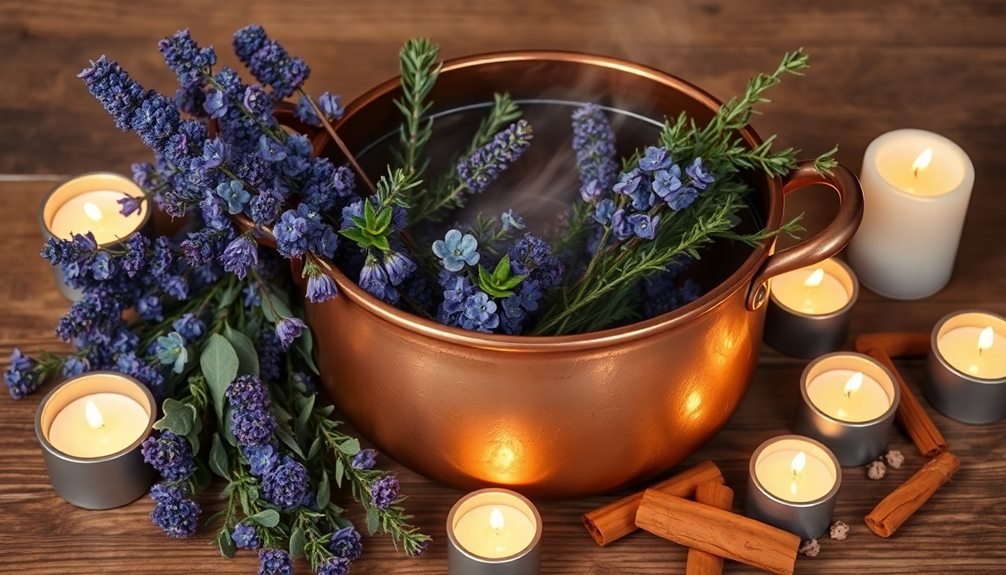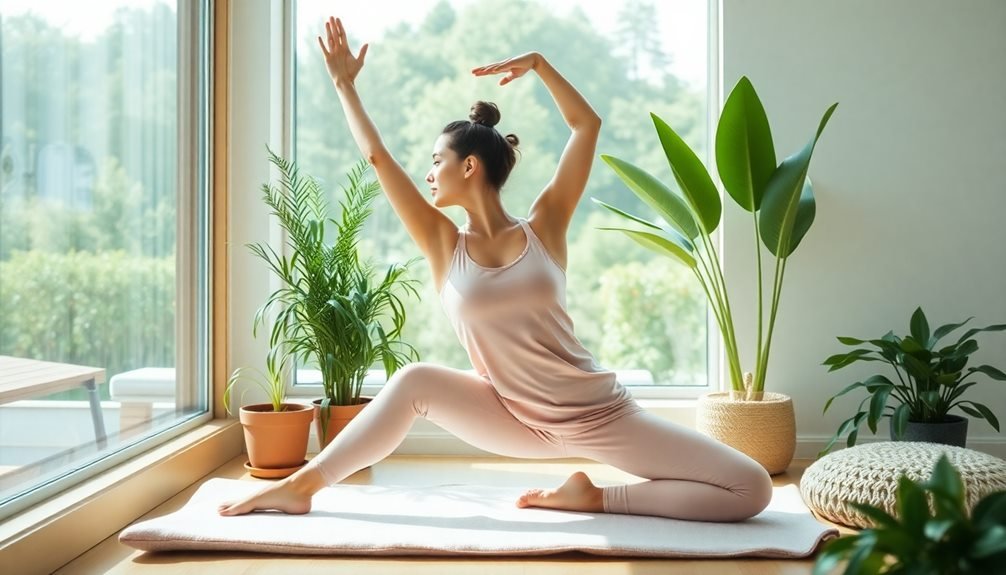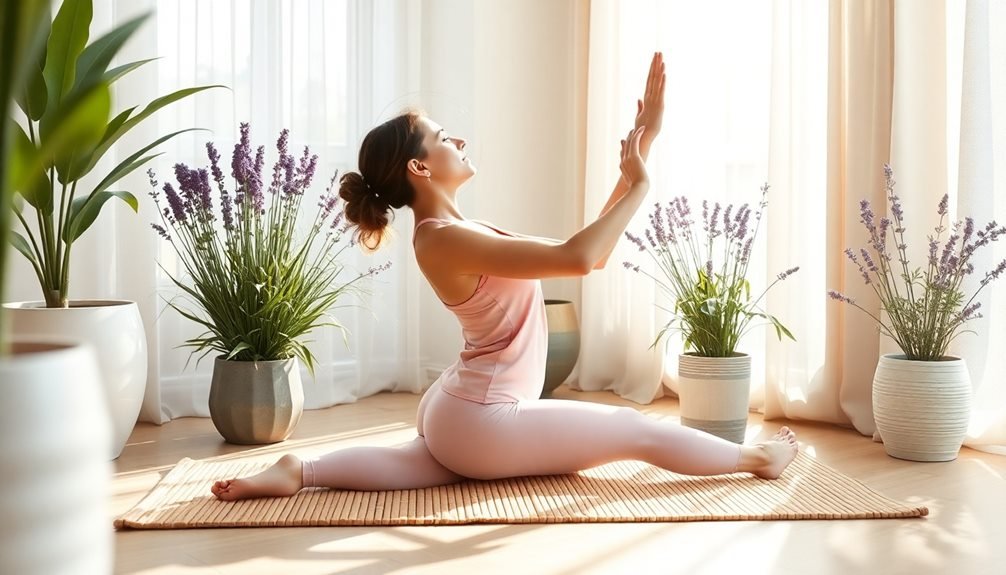Transform your home into a stress-free sanctuary with these seven DIY fragrance solutions. You'll love the calming effects of a lavender reed diffuser in your bedroom, while a citrus peel simmer pot fills your kitchen with uplifting aromas. Create a vanilla bean room spray for instant relaxation, or melt homemade essential oil wax cubes for long-lasting serenity. Place fresh herb sachets in drawers and closets, enjoy the therapeutic benefits of eucalyptus steam bowls, and scatter handmade rose petal potpourri throughout your space. These natural alternatives to commercial air fresheners won't just smell amazing – they'll help you create your own aromatherapy oasis.
Calming Lavender Reed Diffuser

With just a few simple ingredients, you can create a natural lavender reed diffuser that fills your home with soothing aromatherapy.
You'll need 1/4 cup of sweet almond oil, 15-20 drops of pure lavender essential oil, 2 tablespoons of vodka, and 6-8 reed diffuser sticks.
Start by combining the sweet almond oil and vodka in a glass container with a narrow neck. The vodka helps the oils travel up the reeds more effectively while preventing mold growth.
Add your lavender essential oil drops and gently swirl the mixture to blend. Insert the reed sticks and let them soak for 30 minutes before flipping them over.
Place your diffuser in any room where you'd like to create a calm atmosphere – bedrooms and home offices work particularly well.
You'll notice the fragrance intensifying over the first 24 hours. For ideal scent distribution, flip the reeds once a week and replace them every 2-3 months.
If the scent weakens, add 5-10 more drops of lavender oil to refresh the mixture. One batch typically lasts about 3-4 months, depending on room temperature and humidity levels.
Citrus Peel Simmer Pot
On chilly days, a citrus peel simmer pot creates an uplifting and invigorating aroma throughout your home. This natural air freshener combines citrus peels with aromatic spices in simmering water, releasing mood-boosting essential oils into the air.
You'll need orange, lemon, or grapefruit peels, along with complementary ingredients like cinnamon sticks, cloves, and fresh rosemary.
Fill a medium pot with water and add your citrus peels. For a standard 2-quart pot, use peels from 2-3 fruits. Add 2-3 cinnamon sticks, 1 tablespoon of whole cloves, and 2 sprigs of rosemary. Bring the mixture to a boil, then reduce heat to low and let it simmer.
Keep an eye on the water level, adding more as needed to prevent the pot from drying out. You can reuse the same ingredients for 2-3 days by storing them in the refrigerator between uses.
When the peels lose their vibrant color and the spices no longer release their scent, it's time to start fresh. For variety, try adding vanilla extract, star anise, or fresh ginger to create your own signature blend.
Vanilla Bean Room Spray

Soothing and sophisticated, vanilla bean room spray offers a gentle alternative to commercial air fresheners.
You'll need just a few ingredients to create this natural, long-lasting fragrance: two vanilla beans, vodka, distilled water, and an amber glass spray bottle.
Start by splitting the vanilla beans lengthwise and scraping out the seeds.
Place both the seeds and pods into your spray bottle, then add 2 ounces of vodka. The alcohol works as a preservative and helps disperse the fragrance evenly.
Fill the remaining space with distilled water, leaving about an inch of headroom for shaking.
Let your mixture steep for one week in a cool, dark place, shaking it gently every day to help release the vanilla's aroma.
When it's ready, you'll notice the liquid has taken on a rich amber color.
Strain the mixture through a coffee filter to remove any floating particles, then return it to your spray bottle.
You can use this spray on linens, curtains, or as a general room freshener.
The scent typically lasts 3-4 hours, and the spray stays fresh for up to three months when stored properly.
Essential Oil Wax Melts
Creating your own wax melts with essential oils provides a natural and customizable way to scent your home.
You'll need soy wax flakes, your favorite essential oils, silicon molds, and a double boiler to get started. Heat the wax to 185°F, remove from heat, then add 30-40 drops of essential oil per cup of wax.
Pour the mixture into your molds and let them cool completely for about 2 hours. You can experiment with different essential oil combinations like lavender and vanilla for relaxation, or peppermint and eucalyptus for energy.
Once they've hardened, pop them out and store them in an airtight container.
To use your wax melts, place one or two cubes in an electric warmer or tealight melter. They'll typically last 6-8 hours before the scent fades.
Unlike commercial wax melts, these don't contain synthetic fragrances or harmful chemicals. You can also adjust the scent strength by adding more or fewer drops of essential oil during the making process.
For longer-lasting fragrance, try combining fixative oils like cedarwood or patchouli with your chosen scent blend.
Fresh Herb Sachets

Fresh herb sachets let you bring nature's aromas into your home through carefully selected combinations like lavender with rosemary or mint with lemon verbena.
You'll craft these fragrant bundles by wrapping dried herbs in small squares of cotton or linen fabric, then securing them with ribbon or twine to place in drawers, closets, or anywhere you want a gentle scent.
To maintain their potency, store unused sachets in airtight containers away from direct sunlight, and replace the herbs every 3-4 months when their fragrance begins to fade.
Scent Combinations That Work
Aromatic herb sachets bring natural fragrance into any living space, offering a sustainable alternative to commercial air fresheners.
When creating your own herb sachets, you'll want to combine complementary scents that work together harmoniously while providing the desired therapeutic effects.
Consider these proven herb and flower combinations for your sachets:
- Lavender and chamomile – This calming duo promotes relaxation and better sleep, perfect for bedrooms and reading nooks. Add a touch of dried rose petals to enhance the floral notes.
- Rosemary and mint – An invigorating blend that improves focus and mental clarity, ideal for home offices or study areas. Include lemon verbena for an extra citrus boost.
- Sage and thyme – This cleansing combination purifies the air while providing a herbaceous scent. Mix in cedar shavings for added cleanliness and natural moth-repelling properties.
- Pine needles and eucalyptus – A revitalizing forest-inspired blend that helps clear airways and adds a crisp, clean scent to any room. Combine with dried juniper berries for depth.
For longer-lasting fragrance, crush or bruise the herbs slightly before placing them in your sachets, releasing their natural oils.
Crafting Perfect Herb Sachets
Now that you've selected your ideal herb combinations, proper sachet construction will guarantee maximum fragrance diffusion and longevity.
Start by choosing breathable fabric like cotton muslin, linen, or organza that allows scents to permeate while containing the herbs. Cut two 6×6-inch squares and place them with right sides together.
Sew three sides using a 1/4-inch seam allowance, then turn the pouch right-side out. Fill it with your dried herb mixture, leaving about 1/2 inch of space at the top for proper closure. You'll want to gently crush larger herbs before adding them to release more oils.
For sachets that'll last 3-4 months, include fixative herbs like orris root or vetiver to help retain the scent.
Fold the open edges inward and sew the final side closed. You can add a decorative ribbon or twine loop if you plan to hang the sachet.
Store unused herbs in an airtight container away from light and heat to maintain their potency. Replace the contents of your sachets when the scent fades, typically every few months, depending on the herbs used and storage conditions.
Storage and Longevity Tips
Proper storage makes all the difference in extending your herb sachet's lifespan. You'll want to keep your sachets in a cool, dark place away from direct sunlight and moisture to preserve their aromatic qualities. A drawer, closet, or dedicated storage box works perfectly, as long as there's adequate air circulation to prevent mold growth.
When you're not using your sachets, store them in an airtight container or sealed plastic bag to maintain their potency. You'll notice the scent becoming lighter over time, but proper storage can help your sachets last 3-6 months.
- Check your sachets monthly for signs of mold or discoloration – if you spot any, discard them immediately.
- Give sachets a gentle squeeze every few weeks to release oils and refresh the scent.
- Keep sachets away from heat sources like radiators or sunny windowsills to prevent rapid degradation.
- Store different scented sachets separately to prevent fragrance mixing.
If you notice the scent fading, you can rejuvenate your sachets by adding a few drops of essential oil that matches your herbs, or simply replace the dried herbs with fresh ones while reusing the fabric pouches.
Eucalyptus Steam Bowls
Eucalyptus steam bowls offer rapid relief from congestion and help open your airways naturally.
You'll need only a large bowl of hot water and fresh eucalyptus leaves or essential oil to create this therapeutic steam treatment.
Just pour the steaming water into a heat-safe bowl, add your eucalyptus, and drape a towel over your head while you breathe in the cleansing vapors for 5-10 minutes.
Benefits for Clear Breathing
Steam bowls infused with eucalyptus offer powerful relief for congested airways and seasonal allergies. When you breathe in the warm, aromatic vapor, the natural compounds in eucalyptus help break up mucus and reduce inflammation in your respiratory system.
The steam itself moisturizes your nasal passages and throat, making it easier to breathe while fighting off common cold symptoms.
To maximize the benefits of eucalyptus steam therapy for clear breathing, you'll want to be consistent with your practice. Many people find relief from respiratory issues when they use steam bowls before bedtime or first thing in the morning.
- Eucalyptol, the main compound in eucalyptus, works as a natural decongestant and expectorant.
- The steam's warmth helps dilate blood vessels in your nasal passages, reducing swelling and congestion.
- Regular steam sessions can strengthen your respiratory system's natural defense mechanisms.
- The antimicrobial properties of eucalyptus help fight off respiratory infections while soothing irritated airways.
You can enhance these benefits by adding a few drops of tea tree oil or peppermint essential oil to your steam bowl, creating an even more powerful breathing aid.
Quick Setup Instructions
Setting up your aromatherapy steam bowl takes just a few minutes and basic household items. You'll need a large heat-safe bowl, fresh or dried eucalyptus leaves, boiling water, and a clean towel.
Place your bowl on a stable surface where you can sit comfortably for 10-15 minutes.
Add 3-4 cups of boiling water to your bowl, then drop in 5-6 eucalyptus leaves or 3-4 drops of eucalyptus essential oil. Position your face about 12 inches above the bowl to avoid steam burns. Drape the towel over your head and the bowl, creating a tent that traps the aromatic steam.
For the best results, keep these safety measures in mind: Don't place your face too close to the steam, take breaks every 5 minutes if needed, and stop immediately if you experience any discomfort.
You can refresh your steam bowl by adding more hot water when it cools. The entire setup process shouldn't take more than 5 minutes, and you can reuse the same eucalyptus leaves 2-3 times before replacing them.
Store unused leaves in an airtight container for future sessions.
Rose Petal Potpourri

Nature's timeless fragrance comes alive in rose petal potpourri, a classic blend that fills your home with an elegant floral scent.
You'll need fresh rose petals, preferably gathered in the morning when they're most fragrant. Select petals that are free from blemishes and haven't been treated with chemicals.
Once you've collected enough petals, dry them thoroughly on a mesh screen in a warm, dark place for 7-10 days.
Mix your dried rose petals with complementary ingredients like lavender buds, vanilla pods, and orris root powder to create a lasting aroma.
Store your mixture in an airtight container for two weeks, allowing the scents to meld together perfectly.
- Place small sachets of your potpourri in drawers and closets to naturally revitalize clothes
- Display in decorative bowls throughout your home to create fragrant focal points
- Add a few drops of rose essential oil monthly to renew the scent
- Mix with dried citrus peels for a bright, uplifting variation
You can preserve your potpourri's potency by keeping it away from direct sunlight and rejuvenating it seasonally with essential oils.
Frequently Asked Questions
How Long Does the Scent Typically Last Before Needing to Refresh?
You'll typically need to renew your home fragrance every 2-3 days, though it varies based on your room size, ventilation, and scent strength. Some natural fragrances may need daily renewing for ideal results.
Are These Fragrances Safe to Use Around Pets?
You'll need to be careful with essential oils around pets, as some can be toxic. It's best to check with your vet and avoid using tea tree, citrus, pine, and eucalyptus oils near your animals.
Can These DIY Fragrances Trigger Allergies or Sensitivities?
Yes, DIY fragrances can trigger allergies or sensitivities. If you're prone to reactions, you'll want to test small amounts first and avoid essential oils that commonly cause irritation, like peppermint or citrus.
What's the Average Cost Comparison Between DIY and Store-Bought Home Fragrances?
You'll typically spend $2-5 on DIY fragrances per batch compared to $15-30 for store-bought options. Making your own can save you 70-80% while giving you control over ingredients.
Should Pregnant Women Avoid Any Particular Ingredients in These DIY Fragrances?
If you're pregnant, you'll need to avoid certain essential oils like clary sage, rosemary, and pennyroyal. You should also skip artificial fragrances. Always check with your doctor before using any scents.
In Summary
You'll love how these natural DIY fragrances transform your living space into a calming sanctuary. Whether you're simmering citrus peels, diffusing lavender, or creating your own wax melts, you're saving money while avoiding harsh chemicals. Don't forget to experiment with different scent combinations to find what works best for your mood and space. Start with one project and you'll soon be hooked on crafting your own home fragrances.





Leave a Reply